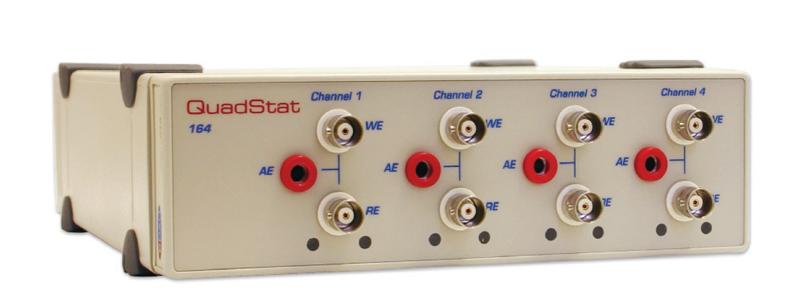EA164 QuadStat

- Four-channel potentiostat 10mA to 200pA range
- Separate/common reference and auxiliary electrodes
- BiPotentiostat
- Ideal for amperometric biosensors, microbial fuel cells, photovoltaic materials and neurochemistry
Overview
The QuadStat is a software-controlled four-channel potentiostat with many Research Advantages (see below). Each channel can be used as a single three-electrode potentiostat. Alternatively two (bipotentiostat), three, or four working electrodes can be used in a single reaction chamber with a common reference and auxiliary electrode. Potential at each working electrode can be independently adjusted between ±2.5 V, or by using an external waveform generator to between ±10 V. The QuadStat can measure currents from pico- to milliamperes, making it ideal for amperometric biosensor research including use as a multichannel monitor for in vivo nitric oxide or dissolved oxgen sensors.
Two QuadStats can be ‘piggybacked’ to provide eight potentiostat channels.
By connecting the corresponding auxiliary and reference electrode leads, the QuadStat can be used as a four channel two-electrode (working and counter electrode) potentiostat. There is also a zero resistance ammeter (ZRA) mode of operation on each channel.
The QuadStat provides up to eight signals (four current and four potential signals) and is recommended for use with e-corder 821 or e-corder 1621 units. The QuadStat is normally sold as part of the ER7005 QuadStat Bundle.
Multichannel operation with included Chart software allows for:
- Simultaneous monitoring of sensors in multiple reaction vessels
- Bipotentiostat operation: two working electrodes with common auxiliary and reference electrode; also 3 or 4 working electrodes with common auxiliary and reference.
- Sensors: use with amperometric sensors providing current signals down to the picoampere ranges
- Neurochemistry: in vivo amperometry for neurotransmitter monitoring
Research Advantages
- Using Chart software you may record signals for very long time periods. The Quadstat system stores the data on the computer hard disk as it goes, so even in the event of a power outage data is saved.
- The recorded signals can be calibrated using one-, two-, or even multi-point calibration (up to twelve points) using linear or nonlinear correction. Removing the need to calibrate after obtaining the recording.
- As analyte additions are made (or other events occur) the use can enter notes directly into the recording and thus the notes will be tied to the signal at the relevant time. These notes are stored within the data file and can be easily recalled and displayed and searched as required.
- As a signal is being collected it is sometimes useful to review that signal and the Chart software supports a ‘split window’ so you can compare the incoming signal with a signal that was recorded at an earlier time. This allows for easy, on the fly, comparisons of previously recorded and actively recording data.
- The user may resize the signal on the computer screen while recording.
- Users can start and stop recording, and change:
– gain sensitivity
– recording speed
– number of sensors being recorded
and keep all the new recordings in the one compacted data file. No proliferation of tens, or even hundreds, of separate disk files that have to be archived. All the recordings made on one day, or even a week, may be kept in a single data file that can be searched based on included notes. - If your signal comprises ‘peaks’ and you need to calculate and tabulate the peak heights and/or areas then you can use several Chart functions to perform this operation. Other features allow you to collect mean signal values (and standard errors) over defined time periods, evalute signal drift, or to fit the signal to idealised exponential or other functions, etc.All recorded signals may be copied and pasted as raw data into Excel (which Chart can also do) which may be needed to perform calculations. Just prepare the final table of results in Chart and copy them straight into a report.
Applications
Research Areas
Application Notes
- Cleaning and Polishing Voltammetric Electrodes
- Cyclic Voltammetry: Hints and Tips
- How to Choose a Potentiostat
Specifications
- Quadstat Potentiostat
Maximum control voltage: ±2.5 V (±10 V with external input)Maximum current per channel: ±10 mA
Compliance voltage: >10 V
>5 V on 10 mA range (high current model)
Input resistance: 1013 Ω || 1 pF
Input bias current: <1 pA @ 25 °C
Current range settings: ±10, 5, 2, 1 mA
±500, 200, 100, 50, 20, 10, 5, 2, 1 μA
±500, 200, 100, 50, 20, 10, 5, 2, 1 nA
±500, 200 pA
I/V Gain: 106, 105, 104, 103, 100, 10, 1, 0.1 nA/V
DC current error: < ±1% FS on ranges 200 nA – 10 mA
< ±0.5% FS on ranges 200 pA – 100 nA
Current signal offset: ±5000 μA on ranges 2 μA – 10mA
±5 μA* on ranges 20 nA – 1 μA
±50 nA* on ranges 200 pA – 10 nA
Low-pass filter: 10 Hz, 3rd order Bessel
e-corder filter settings: 10 kHz to 1 Hz in 10:5:2 steps
Bandwidth, unfi ltered: >10 kHz, on ranges of 20 nA – 10 mA
>1 kHz, on ranges of 200 pA – 10 nA
Drift with temperature: <10 μV/°C
I2C input and output: Male and female DB-9 pin connectors.
Provides control and power.
